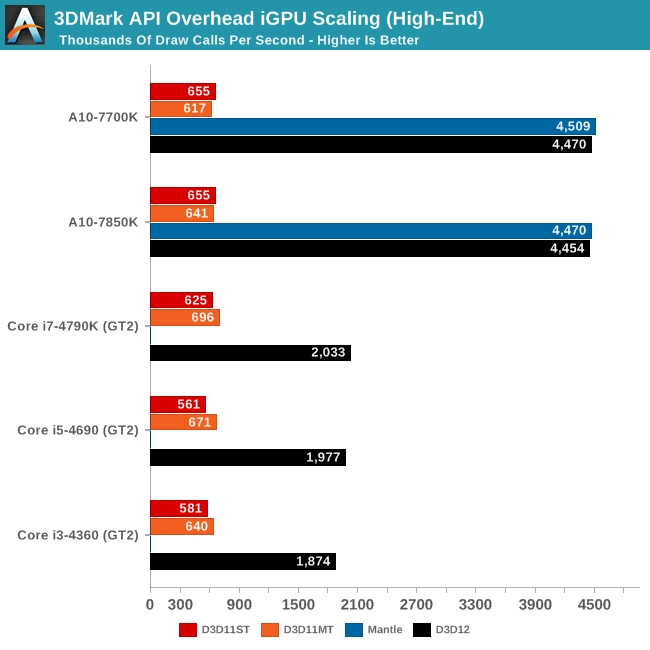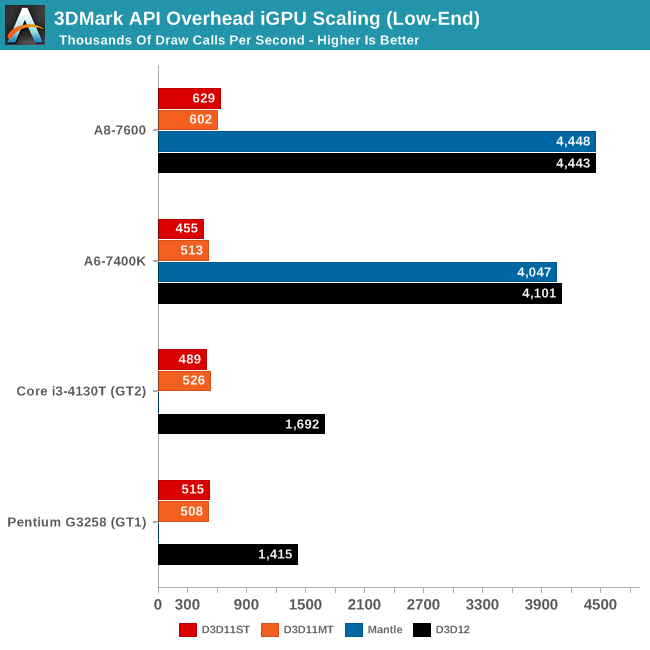Exploring DirectX 12: 3DMark API Overhead Feature Test
by Ryan Smith & Ian Cutress on March 27, 2015 8:00 AM EST- Posted in
- GPUs
- Radeon
- Futuremark
- GeForce
- 3DMark
- DirectX 12
Integrated GPU Testing
Switching gears from high performance discrete GPUs, we have our integrated GPUs. From a high level overview the gains from DirectX 12 are not going to be quite as large here as they are with dGPUs due to the much lower GPU performance, but there is still ample opportunity benefit from increased draw call performance.
Here we have Intel’s Haswell CPUs, and AMD’s Kaveri APUs. We'll start off with the higher-end processors, the Intel Core i3/i5i7 and AMD A10/A8.

As expected, at the high-end the performance gains from DirectX 12 are not quite as great as they were with the dGPUs, but we’re still seeing significant gains. The largest gains of course are found with the AMD processors, thanks to their much stronger iGPUs. From DX11ST to DX12 we’re seeing a surprisingly large 6.8x increase in draw call performance, from 655K to 4,470K.
As to be expected, with a relatively weak CPU, AMD’s DX11 draw call performance isn’t very strong here relative to their strong GPU and of course our more powerful dGPUs. Still, it ends up being better than Intel (who otherwise has the stronger CPU), so we see AMD offering better draw call throughput at all levels. Ultimately what this amounts to is that AMD has quite a bit more potential under DX12.
Mantle meanwhile delivers a very slight edge over DX12 here, although for all practical purposes the two should be considered tied.
Meanwhile for the Intel CPUs, the gains from DX12 aren’t quite as large as with the AMD processors, but they’re still significant, and this is why Intel is happily backing DX12. All 3 processors share the same GT2 GPU and see similar gains. Starting from a baseline of 625K draw calls under DX11 – almost identical to AMD – the i7-4790K jumps up by 3.2x to 2,033K draw calls under DX12. The i5 and the i3 processors see 1,977K and 1,874K respectively, and after adjusting for clockspeeds it’s clear that we’re GPU command processor limited at all times here, hence why even a 2 core i3 can deliver similar gains.
Intel does end up seeing the smallest gains here, but again even in this sort of worst case scenario of a powerful CPU paired with a weak CPU, DX12 still improved draw call performance by over 3.2x. This means that in the long run even games that are targeting lower-performance PCs still stand to see a major increase in the number of draw calls they can use thanks to DirectX 12.

The story is much the same with our lower performance processors. AMD continues to see the largest gains and largest absolute performance under DirectX 12. With a 7x performance increase for the A8, even this weaker processor benefits greatly from the use of a low-level API.
The Intel processors see smaller gains as well, but they too are similarly significant. Even the Pentium with its basic GT1 processor and pair of relatively low clocked CPU sees a 2.7x increase in draw call performance from DirectX 12.










113 Comments
View All Comments
gauravnba - Monday, March 30, 2015 - link
hahaha! You got shunted to page 4 of comments instead.AndrewJacksonZA - Friday, March 27, 2015 - link
@RandomUser15: Almost... ;-)<a href="http://imgur.com/AAtozki"><img src="http://i.imgur.com/AAtozki.jpg" title="source: imgur.com" /></a>
ntam - Friday, March 27, 2015 - link
good for the news but bad because the tech owner, I would like that someday an implementation API would from another standard organization separate it from the Operating system, because in this case Microsoft will force to all users to upgrade the version of Windows but throught the cash register "do you want new directx? just pay for it", even having the last hardware but with a windows 7 you can't use directx 12 at least you have Windows 10 (nearest future), the same will happen with windows 11, 12 onwards.AleXopf - Friday, March 27, 2015 - link
Windows 10 will be a free upgrade for windows 7/8 userspiroroadkill - Friday, March 27, 2015 - link
If you paid any attention at all, you'd know that's already being done, and it's called Vulkan.redviper - Friday, March 27, 2015 - link
The expectation is that Windows 10 will be the last major version of Windows. After this it will be kept evergreen through windows update.And its free (atleast if you upgrade within the year), and will be on all manner of hardware.
inighthawki - Friday, March 27, 2015 - link
An open standard does not solve the problem as well as you'd think, or OpenGL would own the majority marketshare for games. Open standards have their own set of issues.Michael Bay - Friday, March 27, 2015 - link
Development of those technologies costs a lot of money.That`s why MS offsets this cost to the user by denying DX12 to Win7/8.
Cry all you want, they are a for-profit company that acts as a for-profit company, and OpenGL will be bogged down as long as it is designed by a committee.
lordken - Sunday, March 29, 2015 - link
then stay with AMD GPU where you get mantle/vulkan on win7There is absolutely no need to rush for Wi10 uless you own nvidia gpu.
I would petty much guess that new games that will be build on DX12 will prety much have mantle/vulan render support.
Actually in the end, if Vulcan pulls off, it may damage M$ name/reputation that they "forced" (but you stll have choice not to) gamers to upgrade(?)/move to Win10. As Vulcan should be cross-platform and should run on nvidia, unles they decide to screw up n their users
NikosD - Friday, March 27, 2015 - link
Could you add Broadwell iGPU too ?With its 48 EUs, more than double and better in internal architecture than Haswell GT2, we could see a lot better results or not.
A useful addition I think.